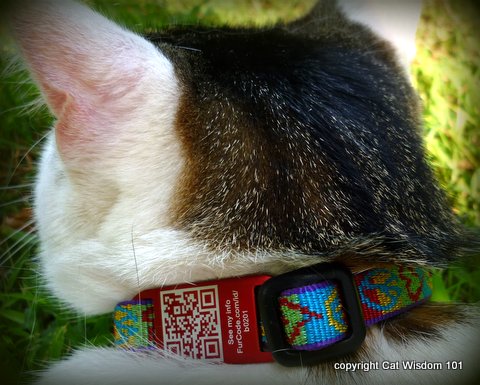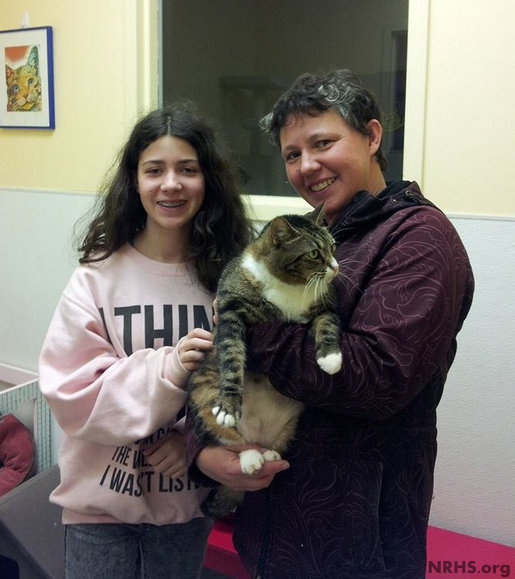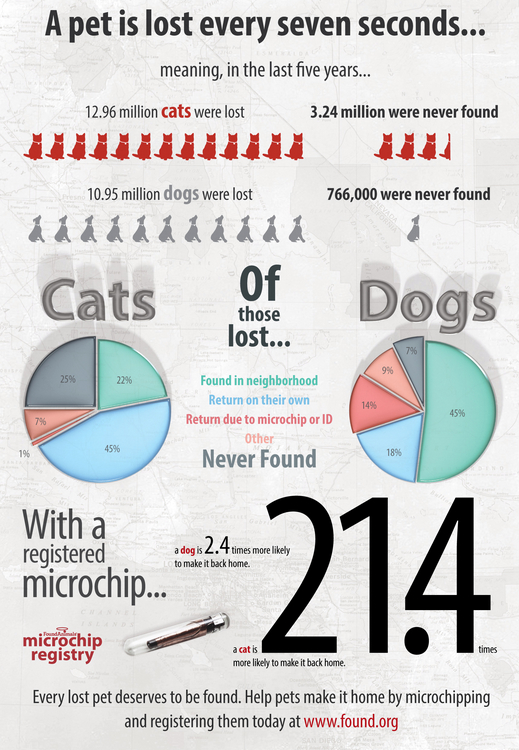
Everything You Ever Wanted To Know About Microchipping & National Pet ID Week
The third week of April is National Pet ID Week. Updated 2023. In lieu of our weekly Shelter Cat Spotlight, we’re sharing a comprehensive FAQ on microchipping your pet all because of a cat named French Fry. Please share our microchip infographic and bonus Q. & A.

In November of 2014, an indoor only cat escaped from his home, got lost and then hit by a car. A good Samaritan brought him to the New Rochelle Humane Society and then rushed to the vet. After recovering “French Fry” a lovely tabby female waited to be adopted. She had a microchip but the information wasn’t updated. French Fry was from Paris, France but had moved at some point to the U.S. She was found in a town area near me in Westchester County but who knew where she lived. The shelter became her temporary home.

The months crawled by and I could tell cage-life was no life for her. French Fry had gained some weight and needed more exercise. She’d recently been moved to the small cage-free area and showed her affectionate nature to everyone. Choosing our spotlight cat of the week is never easy and somehow she got passed over. I figured she was super adoptable and someone would snap her up but thankfully no one did. Yes, she could have found a new found home but Assistant Shelter Manager Anna Lena Larsson never gave up. She finally tracked down the owners (who happen to live in my town). Oooh la la! A happy reunion with “French Fry’s” (real name Tigrette) family took place over a week ago at the shelter.

Not all lost cats are this lucky. To increase the odds of finding a lost pet, ID is must for all pets. In addition to micro-chipping a smart tag or other tag should include the cell and landline phone numbers of the pet parent, an emergency contact umber and address.
The American Veterinary Medical Association has an excellent indepth article about micro-chipping pets. The FAQ on Micro-chipping is printed with permission of the the AVMA.
You can register any microchip for free at Found.org

Q: What is a microchip?
A: A microchip is a small, electronic chip enclosed in a glass cylinder that is about the same size as a grain of rice. The microchip itself does not have a battery—it is activated by a scanner that is passed over the area, and the radiowaves put out by the scanner activate the chip. The chip transmits the identification number to the scanner, which displays the number on the screen. The microchip itself is also called a transponder.

Q: How is a microchip implanted into an animal? Is it painful? Does it require surgery or anesthesia?
A: It is injected under the skin using a hypodermic needle. It is no more painful than a typical injection, although the needle is slightly larger than those used for injection. No surgery or anesthesia is required—a microchip can be implanted during a routine veterinary office visit. If your pet is already under anesthesia for a procedure, such as neutering or spaying, the microchip can often be implanted while they’re still under anesthesia.
Q: What kind of information is contained in the microchip? Is there a tracking device in it? Will it store my pet’s medical information?
A: The microchips presently used in pets only contain identification numbers. No, the microchip is not a GPS device and cannot track your animal if it gets lost. Although the present technology microchip itself does not contain your pet’s medical information, some microchip registration databases will allow you to store that information in the database for quick reference.
Some microchips used in research laboratories and for microchipping some livestock and horses also transmit information about the animal’s body temperature.
Q: What do they mean by “microchip frequency?”
A: The frequency of a microchip actually refers to the frequency of the radiowave given off by the scanner that activates and reads the microchip. Examples of microchip frequencies used in the U.S. include 125 kiloHertz (kHz), 128 kHz, and 134.2 kHz.
Q: I’ve heard about something called “ISO standard.” What does that mean?
A: The International Standards Organization, or ISO, has approved and recommended a global standard for microchips. The global standard is intended to create an identification system that is consistent worldwide. For example, if a dog was implanted with an ISO standard microchip in the U.S. travels to Europe with its owners and becomes lost, the ISO standard scanners in Europe would be able to read the dog’s microchip. If the dog was implanted with a non-ISO microchip and the ISO scanner was not forward- and backward-reading (universal), the dog’s microchip might not be detected or be read by the scanner.
The ISO standard frequency is 134.2 kHz.
Q: What are universal (forward- and backward-reading) scanners? How do they differ from other scanners?
A: Forward-reading scanners only detect 134.2 kHz (ISO standard) microchips, but will not detect 125 kHz or 128 kHz (non-ISO standard) microchips. Universal scanners, also called forward- and backward-reading scanners, detect all microchip frequencies. The main advantage of universal scanners is the improved chances of detecting and reading a microchip, regardless of the frequency. It also eliminates the need for multiple scanners with multiple frequencies.
Q: How does a microchip help reunite a lost animal with its owner?
A: When an animal is found and taken to a shelter or veterinary clinic, one of the first things they do is scan the animal for a microchip. If they find a microchip, and if the microchip registry has accurate information, they can quickly find the animal’s owner.
Q: Will a microchip really make it more likely for me to get my pet back if it is lost?
A: Definitely! A study of more than 7,700 stray animals at animal shelters showed that dogs without microchips were returned to their owners 21.9% of the time, whereas microchipped dogs were returned to their owners 52.2% of the time. Cats without microchips were reunited with their owners only 1.8% of the time, whereas microchipped cats went back home 38.5% of the time. (Lord et al,JAVMA, July 15, 2009) For microchipped animals that weren’t returned to their owners, most of the time it was due to incorrect owner information (or no owner information) in the microchip registry database – so don’t forget to register and keep your information updated.
Q: Does a microchip replace identification tags and rabies tags?
A: Absolutely not. Microchips are great for permanent identification that is tamper-proof, but nothing replaces a collar with up-to-date identification tags. If a pet is wearing a collar with tags when it’s lost, it’s often a very quick process to read the tag and contact the owner; however, the information on the tags needs to be accurate and up-to-date. But if a pet is not wearing a collar and tags, or if the collar is lost or removed, then the presence of a microchip might be the only way the pet’s owner can be found.
Your pet’s rabies tag should always be on its collar, so people can quickly see that your pet has been vaccinated for this deadly disease. Rabies tag numbers also allow tracing of animals and identification of a lost animal’s owner, but it can be hard to have a rabies number traced after veterinary clinics or county offices are closed for the day. The microchip databases are online or telephone-accessed databases, and are available 24/7/365.
Q: I just adopted a pet from the animal shelter. Is it microchipped? How can I find out?
A: If the shelter scanned the animal, they should be able to tell you if it is microchipped. Some shelters implant microchips into every animal they adopt out, so check with the shelter and find out your new pet’s microchip number so you can get it registered in your name.
Most veterinary clinics have microchip scanners, and your veterinarian can scan your new pet for a microchip when you take your new pet for its veterinary checkup. Microchips show up on radiographs (x-rays), so that’s another way to look for one.
Q: Why should I have my animals microchipped?
A: The best reason to have your animals microchipped is the improved chance that you’ll get your animal back if it becomes lost or stolen.
Q: I want to get my animal(s) microchipped. Where do I go?
A: To your veterinarian, of course! Most veterinary clinics keep microchips on hand; so, it is likely that your pet can be implanted with a microchip the same day as your appointment. Sometimes local shelters or businesses will host a microchipping event, too.
Q: Why can’t I just buy the microchip and implant it myself?
A: It looks like a simple-enough procedure to implant a microchip – after all, it’s just like giving an injection, right? Well, yes and no. Although it looks like a simple injection, it is very important that the microchip is implanted properly. Using too much force, placing the needle too deeply, or placing it in the wrong location can not only make it difficult to detect or read the microchip in the future, but it can also cause life-threatening problems. Microchips should really be implanted under supervision by a veterinarian, because veterinarians know where the microchips should be placed, know how to place them, and know how to recognize the signs of a problem and treat one if it occurs.
Q: Once the microchip has been implanted, what do I do? Is there any sort of maintenance needed?
A: There really is no maintenance required for microchips themselves, although you do need to register the microchip and keep your contact information up-to-date in the microchip registration database. If you notice any abnormalities at the site where the microchip was implanted, such as drainage (oozing) or swelling, contact your veterinarian. Ideally, the microchip should be scanned during your animal’s regular wellness/preventive care exams to make sure that it’s still in place and working as it should.
Q: I heard about a dog that was euthanized by a shelter because his microchip wasn’t detected by the shelter’s scanner. How can I know that won’t happen to my pet?
A: Unfortunately, there have been instances where a pet’s microchip was not detected by the animal shelter’s scanner, and the pet was euthanized after the usual holding period because they could not locate its owner. Although these are heartbreaking circumstances, the good news is that this is now unlikely to happen because of the availability of universal (forward-and-backward reading) scanners.
Although the presence of a microchip is not a 100% guarantee that you will get your pet back if it’s lost or stolen, it does dramatically increase the chances you will be reunited with your pet…as long as you keep the registration information up to date.
Q: Why are microchips sometimes not found?
A: As with almost anything, it’s not a foolproof system. Although it’s very rare, microchips can fail and become unable to be detected by a scanner. Problems with the scanners are also not common, but can occur. Human error, such as improper scanning technique or incomplete scanning of an animal, can also lead to failure to detect a microchip.
Some of the animal-related factors that can make it difficult to detect a microchip include the following: animals that won’t stay still or struggle too much while being scanned; the presence of long, matted hair at or near the microchip implantation site; excessive fat deposits in the region of implantation; and a metal collar (or a collar with a lot of metal on it). All of these can interfere with the scanning and detection of the microchip.
See our literature review for guidelines on scanning procedures to reduce the chances of missing a microchip.
Q: My pet has two different frequency microchips implanted. Do I need to have one removed? Will they interfere with each other? Which microchip will be detected by the scanner?
A: No, you do not need to have one of the microchips removed and no, they will not interfere with each other. The microchip detected by the scanner will depend on the scanner used – if it is a universal (forward- and backward-reading) scanner, it will probably detect each chip as it is passed over it. To detect the other chip, the scanner has to be reset and passed over the area where it is located. If it is a scanner that only reads one microchip frequency, it will only detect a microchip of that specific frequency and will not detect or read the other microchip.
If you know your pet has more than one microchip implanted, make sure you keep the database information updated for each microchip. People don’t routinely assume there’s more than one microchip (because it is very uncommon), so they will try to find the owner based on the registry number of the microchip they detect.
Q: My pet has a non-ISO standard, 125 kHz microchip implanted, and I want to have it implanted with an ISO standard, 134 kHz microchip. Can I do that?
A: Sure you can. Both chips will function normally. If your pet is scanned with a scanner that only reads 125 kHz chips, only the 125 kHz chip will be detected. If your pet is scanned with a universal (forward- and backward-reading) scanner, it could detect one or both chips separately (see the question above this one for more information).
Q: I’m relocating to a country that requires ISO chips, and my pet does not have an ISO chip or doesn’t have a microchip at all. What do I need to do?
A: Your pet will need to be implanted with an ISO microchip before it will be allowed into that country. But that’s not the only thing you need to know: countries differ widely on their importation rules, including different regulations about required vaccinations and quarantine periods once the animal enters that country. If you do some research and preparation, your pet’s relocation can go smoothly. Contact the country of origin to determine their requirements regarding microchips as well as vaccinations, certificates, etc. Alternatively, you can contact an experienced animal shipper who is well-versed in the processes and regulations affecting animal shipment.
Q: I’m relocating to a country that requires ISO chips, and my pet has an ISO chip. What do I need to do?
A: In general, your pet won’t need another microchip to be allowed into that country; however, you should check on the destination country’s animal importation regulations as you plan your relocation. That’s not the only thing you need to know: countries differ widely on their importation rules, including different regulations about required vaccinations and quarantine periods once the animal enters that country. If you do some research and preparation, your pet’s relocation can go smoothly. Contact the country of origin to determine their requirements regarding microchips as well as vaccinations, certificates, etc. Alternatively, you can contact an experienced animal shipper who is well-versed in the processes and regulations affecting animal shipment.
Q: Why isn’t it a requirement that all shelters and veterinary clinics use the same microchips and readers? Or, if there are different frequencies of microchips and each requires a separate scanner, why aren’t they required to have one of each scanner so microchips are never missed?
A: There is no federal or state regulation of microchip standards in the U.S., and different manufacturers are able to produce and patent different microchip technologies with different frequencies. Because of market competition, animal shelters and veterinary clinics are able to choose from several microchip manufacturers and scanners. Microchip scanners are relatively expensive, and it is often cost prohibitive keep one or more of each type of microchip scanner.
This problem can be solved by the use of universal microchip scanners, which are readily available. The use of ISO standard microchips would be a good step in developing a consistent microchipping system in the U.S.
Q: When I have my pet microchipped, is there one central database that registers the information and makes it available to animal shelters and veterinary clinics in case my pet is lost or stolen?
A: At this time, there is not a central database in the U.S. for registering microchips; each manufacturer maintains its own database (or has it managed by someone else). Because the ISO standards for identification codes have not been adopted in the U.S., the microchips must be registered with their individual registries.
Fortunately, microchip scanners display the name of the microchip’s manufacturer when the microchip is read. Therefore, the likelihood that an animal cannot be identified from its microchip number is very low—that is, unless your pet’s microchip has not been registered or the information is not accurate.
In 2009, the American Animal Hospital Association launched their Universal Pet Microchip Lookup Tool (www.petmicrochiplookup.org), which provides a listing of the manufacturer with which the microchip’s code is associated as well as if the chip information is found in participating registries. The database does not provide owner information for the microchip – the user must contact the manufacturer/database associated with that microchip.
A number of free microchip databases have been launched over the past few years, but many of these databases are not tied directly to the manufacturers’ databases. Fortunately, some of these databases are integrated into the AAHA Universal Pet Microchip Lookup Tool. Any database with which you register your pet’s microchip needs to be regularly updated, and the critical database to keep up-to-date is the one maintained by the microchip manufacturer.
Q: What are some of the problems associated with microchips? How common are they?
A: The British Small Animal Veterinary Association (BSAVA) maintains a database of adverse reactions to microchips. Since the database was started in 1996, over 4 million animals have been microchipped and only 391 adverse reactions have been reported. Of these reactions, migration of the microchip from its original implantation site is the most common problem reported. Other problems, such as failure of the microchip, hair loss, infection, swelling, and tumor formation, were reported in much lower numbers. For a chart summarizing the BSAVA reports, read the AVMA’s literature review on Microchipping of Animals.
Q: I’ve heard lately that microchips cause cancer. Do they?
A: There have been reports that mice and rats developed cancer associated with implanted microchips. However, the majority of these mice and rats were being used for cancer studies when the tumors were found, and the rat and mice strains used in the studies are known to be more likely to develop cancer. Tumors associated with microchips in two dogs and two cats have been reported, but in at least one dog and one cat the tumor could not be directly linked to the microchip itself (and may have been caused by something else). For more details on the studies, read the AVMA’s literature review on Microchipping of Animals.
Q: I don’t want my pet to get cancer. Should I have my pet’s microchip removed?
A: We do not recommend that you have your pet’s microchip removed, for two reasons. First, based on our review of the studies, the risk that your animal will develop cancer due to its microchip is very, very low, and is far outweighed by the improved likelihood that you will get your animal back if it becomes lost. Second, although implanting a microchip is a very simple and quick procedure, removing one is more involved and may require general anesthesia and surgery.
Q: Do the benefits of microchipping outweigh the risks? I know that you said I have a better chance of being reunited with my lost or stolen pet if it is microchipped, but I’m worried there is still a chance that the veterinary clinic or shelter won’t be able to read the chip or my pet will have a reaction.
A: The benefits of microchipping animals definitely outweigh the risks. Although we can’t guarantee that a shelter or veterinary clinic will always be able to read every microchip, the risk that this will happen is very low, and getting even lower. Animal shelters and veterinary clinics are very aware of the concerns about missing an implanted microchip, and take extra measures to determine if a microchip is present before a decision is made to euthanize or adopt out the animal. Universal scanners are becoming more available, and solve the challenge of detecting different microchip frequencies.
Q: What should I do to “maintain” my pet’s microchip?
A: Once your pet is microchipped, there are only three things you need to do: 1) make sure the microchip is registered; 2) ask your veterinarian to scan your pet’s microchip at least once per year to make sure the microchip is still functioning and can be detected; and 3) keep your registration information up-to-date.
If you’ve moved, or if any of your information (especially your phone number) has changed, make sure you update your microchip registration in the manufacturer’s database as soon as possible.
To remind pet owners to check and update their information, AAHA and the AVMA have established August 15 as “Check the Chip Day.” Take a few minutes to check your information and update it if necessary, and you can rest easy that you’ve improved your chances of getting your pet back if it’s lost or stolen.
This information has been prepared as a service by the American Veterinary Medical Association. Redistribution is acceptable, but the document’s original content and format must be maintained, and its source must be prominently identified. Please contact Dr. Kimberly May (800.248.2862, ext 6667) or Dr. Patricia Wohlferth-Bethke (800.248.2862, ext 6679) with questions or comments


You May Also Like

30 lb. Declawed Cat Rescued From Feral Colony
April 22, 2015
Bulls-eye on Shelter Adoption Success
February 25, 2015

17 Comments
Pingback:
Jenna Hunter
I appreciate your comments on how a microchip is the best way to prevent a pet from getting lost because it goes into a national pet registry that any shelter or vet can scan for. I am thinking about getting a dog for my family and think that I would want to do anything I can to make sure it doesn’t get lost. I will definitely look into microchipping if I do end up getting a dog.
meowmeowmans
Hooray for Tigrette and her family! Thank you for the information about microchipping — this is really important stuff!
The Swiss Cats
We both are microchipped, and we are all for it. Wonderful informative post ! Purrs
Skeeter and Izzy
Thank you Layla for yet another wonderful, informative post!!!
Luvs
Skeeter and Izzy and the Feral Gang + Twig & Peanut & Romeo >^..^<
Kathie
My 4 cats are all microchipped. I wanted to share my story in hopes of advocating microchipping because I know first hand that it works. Last fall, a scrawny, starving cat showed up at our house. I knew he was not feral because it didn’t take much coaxing for him to allow me to approach him. We already have 4 indoor cats and my husband was adamant, no more cats. I didn’t know what I would do with him because none of my friends or family would take him and the only local shelters who would take him are kill shelters. I would never risk an animal’s life taking them to a kill shelter, just can’t do it.We live in a rural area and people tend to drop off unwanted pets near our house, so I assumed he was unwanted or abandoned by owners who moved since people are constantly moving in and out of our subdivision. By the second day, I was starting to get attached to this sweet cat, so I knew I had to figure something out. Without much hope, I put him in a carrier, took him to a local shelter just to get scanned on the off chance that he was microchipped. I was so thrilled to find out that he was indeed chipped! The shelter called the company who gave all the phone numbers to reach the owners. I made several calls that day and the owner cried when I talked to her. She was so happy. She told me that he had been missing for 4 months and her family had looked everywhere for him, putting up posters. He lived merely 6 miles away! I took him to his owners the same day. I also want others to know that no matter what condition an animal is in, don’t assume they are unwanted or don’t have a home. If you find a stray (not a feral, be sure to learn the difference), always get the animal scanned for a microchip.
Kathryn
So glad it worked. I think these microchips are a wonderful idea!
Annabelle
What a great story. WE are so happy that French Fry was reunited with her family and we know they were too.
Melissa & Truffles
French Fry (love that name!) sure has an incredible story! I really do need to talk to my vet about having Truffles microchipped since she refuses to wear a collar of any kind. She’s an indoor cat but accidents happen.
Sue Brandes
Love the name French Fry. Glad there was a happy ending. Thanks for the post.
da tabbies o trout towne
YAY !!!! veree happee ya finded yur way bak two yur peepulz french fry 🙂 ♥ we noe they R veree happee az well….
when sauce & eye leeved de shelter we came frum we left with chips, registrationz info brochures/cards anda tail sa loot ta de staff….
grate post two day doodz & N
♥♥♥
Bev Green
Wonderful Tigrette was reunited ..it is always a good idea to take your pet to get their chips scanned prior to moving house also..we get the girls chips checked at annual vet visits and if we are putting them in boarding we get them checked at their boarding vac visit..the pups too..reason being when we moved and we now live 3 hours from where we were before..Marbles chip had moved…no trace of it..so had to be re done..the vet checked all over..imagine she escaped in a new area no chip…scary..hugs Fozziemum xx
The Island Cats
Thanks for all this good info on microchipping. We’re not microchipped, though we do wear collars with tags. The mom says she is going to get us chipped but she keeps forgetting! We’ll have to remind her again.
easy rider
YAY for Tigrette!!! Thanks for this post, I hope so much that all pets get such a chip. It’s the best chance to find the way back to your crib. It’s required by law in the most european countries…but sadly some peeps ignore that fact, althought the vets have have special offers for chipping…
Sometimes Cats Herd You
We’re big believers in microchipping! A local friend of ours had a cat escape last October and he was returned home last week thanks to his chip. Chips save lives and bring kitties home.
Pawesome Cats
We sure are on the same page today – GREAT MINDS as they say! We’re glad that French Fry had a happy reunion, sadly all cats are not that lucky. See ya soon in Nashville – I’m on the countdown.
Summer
I am microchipped, but my human can’t log into the microchip website! Very frustrating.